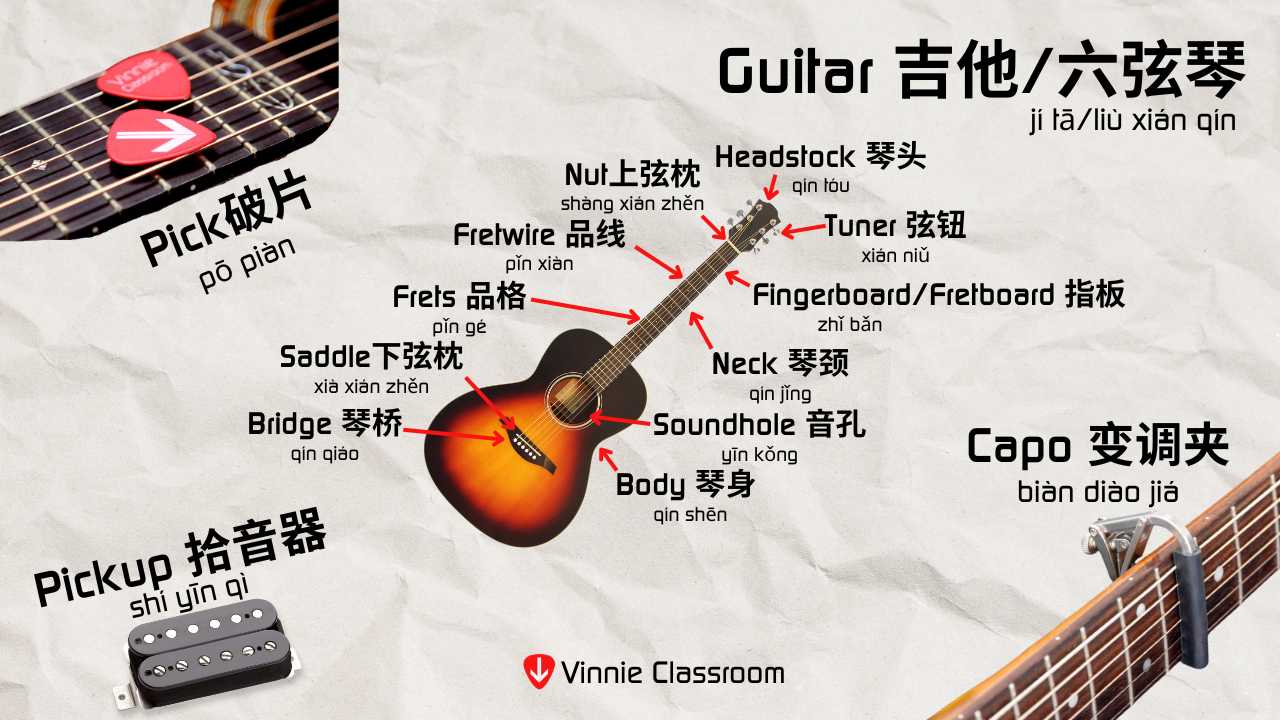Guitar parts name translation: English to Chinese | 吉他英语翻译华语

Why is it important to learn the guitar part’s name in either English or Chinese?
If you haven’t attended guitar lessons, you might not see the importance of learning the names of guitar parts in English, Chinese, or any language. However, knowing these names is essential for clear communication. Imagine wanting to borrow a ruler from a classmate but not knowing the word for it—you’d likely spend a lot of time describing it before they understand. The same applies to guitar lessons; being able to identify guitar parts correctly ensures that students and teachers are on the same page throughout the learning process.
If you’re into comedy, I love the sketch by VLDL about the “Flat Clicker“. It highlights the importance of knowing the item names through a funny scenario.
Taking guitar lessons can help you learn the name of guitar parts!
Guitar lessons are the definitive way to learn about the names of the guitar parts and more. You will be enriched with all the information you need to play and understand the guitar through proper and structured guitar lessons.
We are a music school in Singapore offering guitar lessons at Upper Thomson Road. Signing up for guitar lessons with us means learning from a team with over 10 years of experience running a successful music school in Singapore. Over the years, we have refined our teaching methods to ensure they are engaging, effective, and tailored to suit students of all ages and skill levels. Our commitment to excellence goes beyond lessons—we organize annual recitals! It allows our guitar students to showcase their progress, build confidence, and experience the joy of performing.
List of guitar parts translated from English to Chinese (with Hanyu Pinyin)

- Guitar: 吉他 jí tā
- Guitar: 六弦琴 liù xián qín
- Capo: 变调夹 biàn diào jiā
- Pick: 破片 pō piàn
- Pickup: 拾音器 shí yīn qì
- Headstock: 琴头 qín tóu
- Tuner: 弦钮 xián niǔ
- Neck: 琴颈 qín jǐng
- Fret: 品格 pǐn gé
- Fretwire: 品线 pǐn xiàn
- Fingerboard/Fretboard: 指板 zhǐ bǎn
- Nut: 上弦枕 shàng xián zhěn
- Saddle: 下弦枕 xià xián zhěn
- Soundhole: 音孔 yīn kǒng
- Bridge: 琴桥 qín qiáo
- Body: 琴身 qín shēn
Conclusion
Learning the names of guitar parts in both English and Chinese is essential for effective communication between students and teachers, especially in a multilingual learning environment. It ensures clarity in instructions, minimizes misunderstandings, and helps students follow lessons more efficiently. Whether discussing techniques, troubleshooting issues, or simply understanding feedback, knowing the correct terms in both languages enhances the learning experience. By bridging the language gap, students can focus more on developing their skills and enjoying their musical journey with confidence.
Taking guitar lessons can help you understand more about the guitar! Consider taking a Trial Lesson with us! I am sure with our decade-long experience, we will be of valuable help to you. Contact us through these easy channels! 🙂









